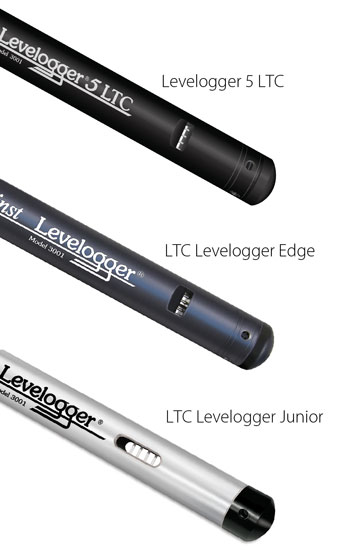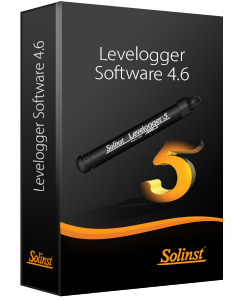Note:
Watch a step-by-step video of a 2-point conductivity calibration for the Levelogger 5 LTC.

Figure 6-1 Levelogger 5 LTC, LTC Levelogger Edge,
and LTC Levelogger Junior
The Levelogger 5 LTC, LTC Levelogger Edge and LTC Levelogger Junior conductivity sensors must be calibrated for reliable conductivity measurements. Calibrate for conductivity at the start of each new monitoring project or at a minimum each new monitoring season (twice a year).
Calibrating the LTC Levelogger directly after the monitoring project or season will provide information on the degree of conductivity deviation during the project or season. If necessary, readings can be corrected for any conductivity deviation in a spreadsheet program after the data has been exported.
The process of conductivity calibration is performed automatically by use of the Calibration Wizard. You place the LTC Levelogger in a specified calibration solution and follow the steps provided by the wizard. Conductivity calibration solutions are available from Solinst or any laboratory supply outlet.
The Levelogger 5 LTC and LTC Edge have a 100,000 µS/cm conductivity range and a calibrated range from 50 to 80,000 µS/cm. They can be calibrated to 4 calibration standard points:
- 1,413 μS/cm
- 5,000 μS/cm
- 12,880 μS/cm
- 80,000 μS/cm
The LTC Levelogger Junior has an 80,000 μS/cm conductivity range and a calibrated range from 500 to 50,000 μS/cm. It can be calibrated to 3 calibration standard points:
- 1,413 μS/cm
- 5,000 μS/cm
- 12,880 μS/cm
If you know the approximate conductivity range of the water that you will be measuring, best accuracy when calibrating your unit is to select two calibration points—one above, and one below that range. If you are measuring in water less than 1,413 µS/cm or above 80,000 µS/cm (above 12,880 µS/cm for the LTC Levelogger Junior), use just one calibration solution.
The solution(s) and LTC must be between 10ºC and 30ºC during actual calibration. Temperature should remain stable during the 10 - 20 seconds it takes to perform each calibration. Use Real Time View to confirm that you have reached thermal equillibrium prior to calibration.
For best accuracy, it is recommended you use calibration solutions that have a temperature error of ±2% or better. You should also keep the solution as close to the stated temperature on the bottle as possible (i.e. 25ºC). The closer you get to the temperature extremes of 10ºC and 30ºC, the less accurate your calibrations may be.




